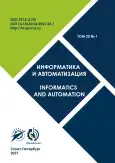Holding Geostationary Satellite at Given Standing Point, Taking into Account Additional Phase Restrictions
- Autores: Gorbulin V.I1, Kotyashov E.V1, Chernyavskiy V.A1, Gruzdev N.V1
-
Afiliações:
- Mozhaisky Military Space Academy
- Edição: Volume 20, Nº 1 (2021)
- Páginas: 43-67
- Seção: Robotics, automation and control systems
- URL: https://journal-vniispk.ru/2713-3192/article/view/266297
- DOI: https://doi.org/10.15622/ia.2021.20.1.2
- ID: 266297
Citar
Texto integral
Resumo
A great attention is being paid to rational power units placing during the projection of new space shuttles, especially those with long useful lifetime. In this article, it is assumed that SESs are equipped with several correction motors, which make it possible to create control accelerations in only several directions, without changing the orientation of the SES itself. In other words, in this task it is assumed that the corrections of the parameters of the AES orbit do not affect the orientation of the SAES itself. This condition is a severe limitation in the synthesis of the SES’s control system.
In the considered methodological approach, the costs of the working fluid are set as a functionality from control, which are necessary to perform the next correction, after which the SAES will not have dangerous distances and approaching in projection horizon’s interval. This makes it possible to avoid situations when the decision on control is being made after the SES leaves the vicinity of the station point, and first of all, the approach to the SDO at a distance less than a liminal one. This article provides the results of modeling, which indicate the effectiveness of the proposed solutions.
An important advantage compared with the existing methods is the consideration of the movement of the SAES relatively not only to the stationary point, but also to several other objects located in its vicinity, both controlled and uncontrolled. Moreover, there can be any given number of objects.
Sobre autores
V. Gorbulin
Mozhaisky Military Space Academy
Email: v_gorbulin@mail.ru
Zdanovskaya str. 13
E. Kotyashov
Mozhaisky Military Space Academy
Email: kev246@mail.ru
Zdanovskaya str. 13
V. Chernyavskiy
Mozhaisky Military Space Academy
Email: vladimirchernyavsky@yandex.ru
Zdanovskaya str. 13
N. Gruzdev
Mozhaisky Military Space Academy
Email: nikgruzdew@rambler.ru
Zdanovskaya str. 13
Bibliografia
- Урличич Ю.М. и др. Современные технологии навигации геостационарных спутников // М.: ФИЗМАТЛИТ. 2006. 280 с.
- Красильщиков М.Н., Малышев В.В., Федоров А.В. Автономная реализация динамических операций на геостационарной орбите. I. Формализация задачи управления // Известия Российской академии наук. Теория и системы управления. 2015. № 6. С. 82–96.
- Красильщиков М.Н., Малышев В.В., Федоров А.В. Автономная реализация динамических операций на геостационарной орбите. II. Синтез алгоритмов управления // Известия Российской академии наук. Теория и системы управления. 2016. № 6. С. 107–128.
- Архипов Ю.С. и др. Разработка двигательной подсистемы коррекции орбиты на базе двигателя КМ-60 для геостационарного космического аппарата // Космонавтика и ракетостроение. 2016. № 5(90). С. 24–34.
- Авксеньтев А.А. и др. Оптимизация схемы выведения космического аппарата с ограничениями по выбору интервалов включения двигательной установки // Вопросы электромеханики. 2012. № 5. С. 7–13.
- Салмин В.В., Четвериков А.С. Приближённое решение плоской задачи терминального управления геостационарным спутником с помощью двигателя малой тяги // Материалы ХVII конференции молодых ученых. ГНЦ РФ АО «Концерн «ЦНИИ «Электроприбор». 2015. С. 115–121.
- Авксеньтев А.А. и др. Оптимизация схемы выведения космического аппарата с ограничениями по выбору интервалов включения двигательной установки // Вопросы электромеханики. 2012. № 5. С. 7–13.
- Брагинец В.Ф. и др. Приоритетные стратегии коллокации геостационарных спутников, находящихся в общих орбитальных позициях, для предотвращения опасных сближений. // Космонавтика и ракетостроение. 2016. № 8(93). С. 98–109.
- Сухой Ю.Г. Оценка влияния потенциалов Солнца и Луны на наклонение орбиты геостационарного спутника. // Космонавтика и ракетостроение. 2016. № 6(91). С. 67–77.
- Сухой Ю.Г., Брагинец В.Ф. Стратегия коррекции наклонения орбиты геостационарного спутника с учетом эволюции наклонения на длительных интервалах времени под действием гравитационных потенциалов Солнца и Луны // Инженерный журнал: наука и инновации. 2018. Вып. 7. 24 c.
- Сухой Ю.Г., Брагинец В.Ф., Мещеряков В.М. Особенности управления орбитальным движением геостационарных спутников в условиях их коллокации // Инженерный журнал: наука и инновации. 2019. № 3(87). 9 c.
- Азанов В.М., Кан Ю.С. Оптимизация коррекции околокруговой орбиты искусственного спутника Земли по вероятностному критерию // Труды ИСА РАН. 2015. № 2. С. 18–26.
- Soop M. Handbook of Geostationary Orbits. Space Technology Library // Kluwer Academic Publishers. 1994.
- Mattias Soop E. Introduction to Geostationary Orbits // European Space Agency (ESA). 1983.75 p.
- Jasour A.M., Aybat N.S., Lagoa C.M. Semidefinite Programming For Chance Constrained Optimization Over Semialgebraic Sets // SIAM J. Optim. 2015. vol. 25. no. 3. pp. 1411–1440.
- Jasour A.M., Lagoa C.M. Convex Chance Constrained Model Predictive Control // arXiv preprint arXiv:1603.07413. 2016.
- Kluever C. Simple Guidance Scheme for Low-Thrust Orbit Transfers // Journal of Guidance, Control, and Dynamics. 1998. vol. 21. no. 6. pp. 1015–1017.
- Eastwood J.P. et al. Sunjammer // Weather. 2015. vol. 70. no.1. pp. 27–30.
- Kelly P. et al. Solar radiation pressure applications on geostationary satellites // Proceedings of the 2016 AAS GP & C Conference. American Astronautical Society. 2016.
- Angel Borja J., Dioisio T. Deorbit Process using Solar Radiation Force // Journal of Spacecraft and Rockets. 2006. vol. 43. no. 3. pp. 685–687.
- Guo R. et al. Precise orbit determination and rapid orbit recovery supported by time synchronization // Adv. Space Res. 2015. vol. 55. pp. 2889–2898.
- Guo R., Chen J., Zhu L. Kinematic Orbit Determination Method Optimization and Test Analysis for BDS Satellites with Short-arc Tracking Data // Acta Geod. Cartogr. Sin. 2017. vol. 46. pp. 411–420.
- Ju B. et al. Precise orbit and baseline determination for maneuvering low earth orbiters // GPS Solut. 2017. vol. 21. pp. 53–64.
- Du L. et al. An 18-element GEO broadcast ephemeris based on non-singular elements // GPS Solut. 2015. vol. 19. pp. 49–59.
- Zhao C.Y. et al. Analysis on the long-term dynamical evolution of the inclined geosynchronous orbits in the Chinese BeiDou navigation system // Adv. Space Res. 2015. vol. 56. pp. 377–387.
Arquivos suplementares









